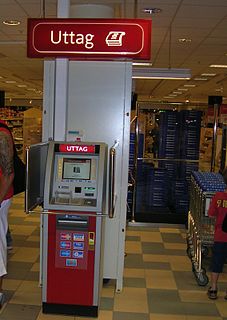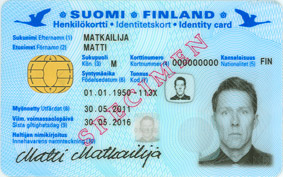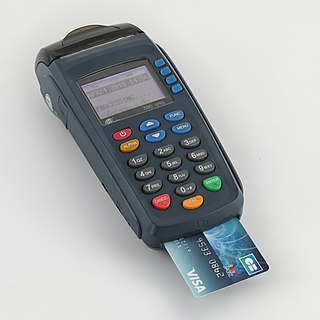A debit card is a plastic payment card that can be used instead of cash when making purchases. It is similar to a credit card, but unlike a credit card, the money is immediately transferred directly from the cardholder's bank account when performing any transaction.

Electronic funds transfer at point of sale is an electronic payment system involving electronic funds transfers based on the use of payment cards, such as debit or credit cards, at payment terminals located at points of sale. EFTPOS technology originated in the United States in 1981 and was adopted by other countries. In Australia and New Zealand, it is also the brand name of a specific system used for such payments; these systems are mainly country-specific and do not interconnect.

An automated teller machine (ATM) or cash machine is an electronic telecommunications device that enables customers of financial institutions to perform financial transactions, such as cash withdrawals, deposits, funds transfers, or account information inquiries, at any time and without the need for direct interaction with bank staff.

A smart card, chip card, or integrated circuit card is a physical electronic authorization device, used to control access to a resource. It is typically a plastic credit card-sized card with an embedded integrated circuit (IC) chip. Many smart cards include a pattern of metal contacts to electrically connect to the internal chip. Others are contactless, and some are both. Smart cards can provide personal identification, authentication, data storage, and application processing. Applications include identification, financial, mobile phones (SIM), public transit, computer security, schools, and healthcare. Smart cards may provide strong security authentication for single sign-on (SSO) within organizations. Numerous nations have deployed smart cards throughout their populations.

A magnetic stripe card is a type of card capable of storing data by modifying the magnetism of tiny iron-based magnetic particles on a band of magnetic material on the card. The magnetic stripe, sometimes called swipe card or magstripe, is read by swiping past a magnetic reading head. Magnetic stripe cards are commonly used in credit cards, identity cards, and transportation tickets. They may also contain an RFID tag, a transponder device and/or a microchip mostly used for business premises access control or electronic payment.

A proximity card or prox card is a contactless smart card which can be read without inserting it into a reader device, as required by earlier magnetic stripe cards such as credit cards and contact type smart cards. The proximity cards are part of the contactless card technologies. Held near an electronic reader for a moment they enable the identification of an encoded number. The reader usually produces a beep or other sound to indicate the card has been read.
Electronic cash was until 2007 the debit card system of the German Banking Industry Committee, the association which represents the top German financial interest groups. Usually paired with a transaction account or current account, cards with an Electronic Cash logo were only handed out by proper credit institutions. An electronic card payment was generally made by the card owner entering their PIN at a so-called EFT-POS-terminal (Electronic-Funds-Transfer-Terminal). The name “EC” originally comes from the unified European checking system Eurocheque. Comparable debit card systems are Maestro and Visa Electron. Banks and credit institutions who issued these cards often paired EC debit cards with Maestro functionality. These combined cards, recognizable by an additional Maestro logo, were referred to as “EC/Maestro cards”.

Magnetic ink character recognition code, known in short as MICR code, is a character recognition technology used mainly by the banking industry to streamline the processing and clearance of cheques and other documents. MICR encoding, called the MICR line, is at the bottom of cheques and other vouchers and typically includes the document-type indicator, bank code, bank account number, cheque number, cheque amount, and a control indicator. The format for the bank code and bank account number is country-specific.

EMV is a payment method based upon a technical standard for smart payment cards and for payment terminals and automated teller machines which can accept them. EMV originally stood for "Europay, Mastercard, and Visa", the three companies which created the standard.

Maestro is a brand of debit cards and prepaid cards owned by Mastercard that was introduced in 1991. Maestro debit cards are obtained from associate banks and are linked to the cardholder's current account while prepaid cards do not require a bank account to operate. Maestro cards can be used at point of sale (POS) and ATMs. Payments are made by swiping cards through the payment terminal, insertion into a chip and PIN device or by a contactless reader. The payment is authorized by the card issuer to ensure that the cardholder has sufficient funds in their account to make the purchase. The cardholder then confirms the payment by either signing the sales receipt or entering their 4- to 6-digit PIN, except with contactless transactions below a specified amount for which no further verification is required.
A currency detector or currency validator is a device that determines whether notes or coins are genuine or counterfeit. These devices are used in a wide range of automated machines, such as retail kiosks, supermarket self checkout machines, arcade gaming machines, payphones, launderette washing machines, car park ticket machines, automatic fare collection machines, public transport ticket machines, and vending machines.

Payment cards are part of a payment system issued by financial institutions, such as a bank, to a customer that enables its owner to access the funds in the customer's designated bank accounts, or through a credit account and make payments by electronic funds transfer and access automated teller machines (ATMs). Such cards are known by a variety of names including bank cards, ATM cards, MAC, client cards, key cards or cash cards.
A card reader is a data input device that reads data from a card-shaped storage medium. The first were punched card readers, which read the paper or cardboard punched cards that were used during the first several decades of the computer industry to store information and programs for computer systems. Modern card readers are electronic devices that can read plastic cards embedded with either a barcode, magnetic strip, computer chip or another storage medium.

A contactless smart card is a contactless credential whose dimensions are credit-card size. Its embedded integrated circuits can store data and communicate with a terminal via NFC. Commonplace uses include transit tickets, bank cards and passports.
The payment card industry (PCI) denotes the debit, credit, prepaid, e-purse, ATM, and POS cards and associated businesses.

A payment terminal, also known as a Point of Sale (POS) terminal, credit card terminal, EFTPOS terminal, is a device which interfaces with payment cards to make electronic funds transfers. The terminal typically consists of a secure keypad for entering PIN, a screen, a means of capturing information from payments cards and a network connection to access the payment network for authorization.

The Chip Authentication Program (CAP) is a MasterCard initiative and technical specification for using EMV banking smartcards for authenticating users and transactions in online and telephone banking. It was also adopted by Visa as Dynamic Passcode Authentication (DPA). The CAP specification defines a handheld device with a smartcard slot, a numeric keypad, and a display capable of displaying at least 12 characters. Banking customers who have been issued a CAP reader by their bank can insert their Chip and PIN (EMV) card into the CAP reader in order to participate in one of several supported authentication protocols. CAP is a form of two-factor authentication as both a smartcard and a valid PIN must be present for a transaction to succeed. Banks hope that the system will reduce the risk of unsuspecting customers entering their details into fraudulent websites after reading so-called phishing emails.
An MM code is a "machine-readable modulated" feature that has been added to German debit cards during manufacture as an anti-counterfeiting measure since 1979. It was developed by "Gesellschaft für Automation und Organisation" in Munich for the German ec-Card system and MM verification devices have been added to German ATMs from 1982 onwards. If a payment card contains an MM code as well as a magnetic stripe, any fraudster who counterfeits the card but fails to read and duplicate the MM code onto the copy will be detected when trying to use the counterfeit in a German automated teller machine.

A card security code (CSC), card verification data (CVD), card verification number, card verification value (CVV), card verification value code, card verification code (CVC), verification code, or signature panel code (SPC) is a security feature for "card not present" payment card transactions instituted to reduce the incidence of credit card fraud.
A DIP reader is an electronic device for reading an electronically encoded card that is inserted and then removed from the device.












